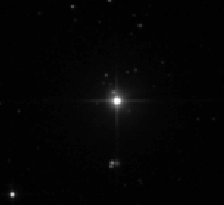AU Microscopii
|
Star AU Microscopii |
|||||||||||||||||
|---|---|---|---|---|---|---|---|---|---|---|---|---|---|---|---|---|---|

|
|||||||||||||||||
| 2MASS image from AU Microscopii | |||||||||||||||||
| AladinLite | |||||||||||||||||
|
Observation dates equinox : J2000.0 , epoch : J2000.0 |
|||||||||||||||||
| Constellation | microscope | ||||||||||||||||
| Right ascension | 20 h 45 m 9.53 s | ||||||||||||||||
| declination | -31 ° 20 ′ 27.2 ″ | ||||||||||||||||
| Apparent brightness | 8,627 likes | ||||||||||||||||
| Typing | |||||||||||||||||
| B − V color index | 1.45 | ||||||||||||||||
| U − B color index | 1.01 | ||||||||||||||||
| Spectral class | M1Ve | ||||||||||||||||
| Variable star type | BY-Draconis star | ||||||||||||||||
| Astrometry | |||||||||||||||||
| Radial velocity | −4.50 ± 0.25 km / s | ||||||||||||||||
| parallax | 100.91 ± 1.06 mas | ||||||||||||||||
| distance | 32.3 ± 0.3 ly 9.9 ± 0.1 pc |
||||||||||||||||
| Visual absolute brightness M vis | 8.61 likes | ||||||||||||||||
| Proper movement | |||||||||||||||||
| Rec. Share: | 279.96 ± 1.26 mas / a | ||||||||||||||||
| Dec. portion: | −360.61 ± 0.73 mas / a | ||||||||||||||||
| Physical Properties | |||||||||||||||||
| Dimensions | 0.31 M ☉ | ||||||||||||||||
| radius | 0.84 R ☉ | ||||||||||||||||
| Luminosity |
0.09 L ☉ |
||||||||||||||||
| Effective temperature | 3,500 ± 100 K | ||||||||||||||||
| Rotation time | 4.9 d | ||||||||||||||||
| Age | 12 ± 2 million a | ||||||||||||||||
|
Other names and catalog entries |
|||||||||||||||||
|
|||||||||||||||||
AU Microscopii is a red dwarf in the constellation microscope , which is about 32.3 light-years from the sun away. It is a variable star and therefore has a variable name . AU Microscopii probably forms a triple star system with the neighboring double star AT Microscopii . A debris disk was detected around him .
properties
AU Microscopii has measurement data and the resulting model calculations according to a radius of 84% of the solar radius and a mass of 31% of the solar mass . Its luminosity is only 9% of the sun's luminosity . AU Microscopii is only about 12 million years old, making it significantly younger than the Sun.
The star belongs to the Beta Pictoris motion cluster and possibly arose together with Beta Pictoris (after which this motion cluster is named) and AT Microscopii (Gliese 799). With the latter, a double star, AU Microscopii likely to form a very wide triple system, the mutual spacing of about 0.226 Parsec was estimated. It is a flare star that was observed, among other things, by the space telescopes IUE and EUVE in the ultraviolet light and ROSAT in the X-ray range.
Debris disk

With the help of the 2.2 m telescope from the University of Hawaii at the Mauna Kea Observatory , a disk of debris was detected in a radius of 50 to 210 AU around AU Microscopii. From the earth this debris disk can be seen almost exactly from its side.
Further observations revealed clumps and gaps within the debris disk, which may indicate the existence of orbiting planets. However, the search for exoplanets around AU Microscopii has so far been unsuccessful, although planets with comparatively low masses are not excluded. The inner disc is asymmetrical.
Web links
- SolStation.com: AU and AT Microscopii AB. Retrieved July 29, 2015 . (English)
Individual evidence
- ↑ a b c d e f SIMBAD: AU Microscopii. Retrieved July 29, 2015 .
- ↑ a b c d e f g h i Plavchan, Peter et al .: New Debris Disks Around Young, Low Mass Stars Discovered With The Spitzer Space Telescope . arxiv : 0904.0819 .
- ^ Barrado y Navascués, David et al .: The Age of Beta Pic . arxiv : astro-ph / 9905242 .
- ↑ Caballero, Jose A .: Reaching the boundary between stellar kinematic groups and very wide binaries. The Washington Double Stars with the widest angular separations . arxiv : 0908.2761 .
- ^ Cully, Scott L. et al .: Rotational modulation and flares on RS CVn and BY DRA systems. II - IUE observations of BY Draconis and AU Microscopii . bibcode : 1987A & A ... 174..139B .
- ↑ Tsikoudi, V .; Kellett, BJ: ROSAT All-Sky Survey X-ray and EUV observations of YY Gem and AU Mic . bibcode : 2000MNRAS.319.1147T .
- ↑ Kalas, Paul; Liu, Michael C .; Matthews, Brenda C .: Discovery of a large dust disk around the nearby star AU Microscopium . arxiv : astro-ph / 0403132 .
- ↑ a b Metchev, Stanimir et al .: Adaptive Optics Imaging of the AU Microscopii Circumstellar Disk: Evidence for Dynamical Evolution . arxiv : astro-ph / 0412143 .
- ^ Masciadri, Elena et al .: A search for hot massive extrasolar planets around nearby young stars with the adaptive optics system NACO . arxiv : astro-ph / 0502376 .
- ^ Liu, Michael C .: Substructure in the Circumstellar Disk around the Young Star AU Mic (GJ 803) . arxiv : astro-ph / 0408164 .